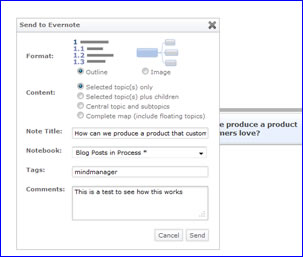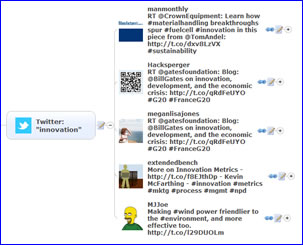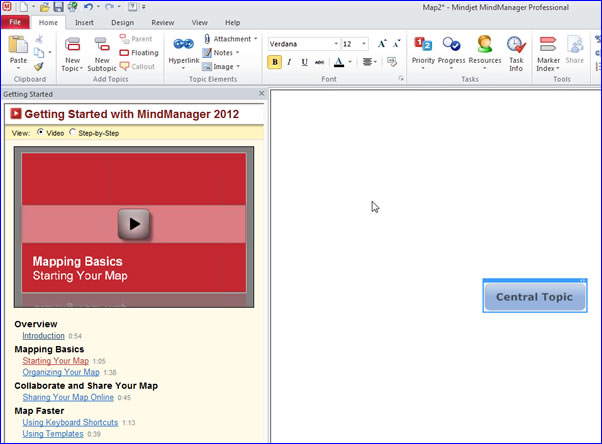As part of Mindjet’s intensified focus on collaboration and team communication, MindManager 2012 was officially released today. It picks up some new features that help to support this direction, as well as some others designed to enhance the experience for new users of MindManager.
Here’s is a summary of the most significant new and enhanced features of MindManager 2012:
Helping new users get started faster
Redesigned ribbon toolbar: Mindjet has redesigned the toolbar in MindManager 2012 to place 80-90 percent of the most commonly-used features on the home tab. This makes it easier for new users to find the commands they’re looking for without leaving this tab, and should also speed the work of all users.
Video guides: The new program ships with a set of video guides (above) that appear in a panel on the left side of the work space, which explain how to perform common tasks with the program, as well as tips on what types of tasks it can be used for.
Right-hand tabs: The set of tabs on the right-hand side of the work space, which give access to icons, images, smart map parts and task data, are hidden by default for new users. The developer’s intent is to reduce the amount of visual clutter on the screen, which tends to confuse new users. They can be turned back on by clicking on the small folder icon in the lower right corner of the work space. Mindjet officials say that if you are upgrading from an earlier version, this “newbie” feature will be turned off – in other words, if you had tabs visible, they will still be there after you upgrade to the 2012 version.
Integration with online gallery: MindManager 2012 also displays mind maps from the developer’s growing MapsForThat.com map gallery, giving users access to hundreds of additional examples and starting points they can adapt for their own projects. In the template viewer, maps are categorized by type, with thumbnail images and explanations in a panel next to them. It was very slick to be able to drill down through this great collection of maps, which displayed and loaded quickly over a high-speed internet connection.
New users of mind mapping software almost always need some inspiration, according to my surveys. They want to see what others are doing with it. This integrated viewer is an awesome way to bring these map examples to users of MindManager 2012, within the program itself.
Longer term, Mindjet plans to make it possible to upload maps directly from MindManager to MapsForThat. If you want to be a thought leader in the mind mapping space, now’s the time to take MapsForThat seriously. As usage of the new version grows, your mind maps will be accessible to thousands of users worldwide!
Brainstorming capabilities
One of the most exciting new developments in MindManager 2012, at least for me (because I also write about creativity tools and software on InnovationTools.com) is the program’s new brainstorming feature. The developer licensed an add-in called TheRealizer (click here to read my review of it), and significantly expanded and improved it, with the help of the firm that created it. It now offers users of MindManager a process for defining a problem or challenge, generating ideas and evaluating them.
The program ships with predefined challenges; you can also create your own. Stimulation is provided by a large collection of question, image and word cards, which are designed to get your mind thinking in fresh, new directions. Finally, ideas can be categorized using a set of pre-defined idea types – or, once again, you can add your own types. Plus, MindManager 2012 provides a number of methods for refining your ideas, including Edward de Bono’s 6 Thinking Hats and attribute analysis. This is bound to be a powerful tool for many users of MindManager 2012.
Watch this blog for a separate post on this new feature. I interviewed Michael Deutch from Mindjet to learn more about how, specifically, this new toolset compares to TheRealizer. I was pleasantly surprised at just how far the team has expanded it. More details to come!
Real-time collaboration
MindManager 2012 will fully integrate with the new Connect workspace (see here for my coverage of it) and its CoHuman social task management component. A basic Connect account is free; Users of the desktop program and web client will be able to co-edit mind maps in real time; Mindjet says they plan to extend this capability to all of its mind map clients, regardless of platform – which means you will be able to co-edit maps from their mobile apps as well.
From within the program, I was able to use my Mindjet login as a springboard to create a new Connect account. I then signed into it from MindManager, created a simple map and saved it to Connect. It all worked very smoothly.
Other productivity enhancements
Multiple hyperlinks and attachments per topic: This is something that Mindjet has needed to do for a while, and I’m glad to see it in the 2012 version. I tried adding two random attachments to a topic in the program. The minute I added a second attachment, the paperclip icon gained a down arrow next to it, which can be used to display and select the list of attachments.
Enhanced integrated web browser: Since the integrated web browser debuted in MindManager several years ago, I have been disappointed that I couldn’t drag and drop content from web pages into my mind maps. MindManager 2012 will now support this capability. Also, Mindjet has added a home page icon to the browser’s toolbar, to make it more like a full desktop browser.
Improved power filter: MindManager’s power filter has always been an excellent tool. It’s just not that easy to figure out how to use at first glance. To address this issue, Mindjet has equipped its latest version of MindManager with a number of pre-set filters (above). This will help to transform the power filter from a tool only for power users into one that anyone can benefit from.
Powermarkers added: This is another tool that formerly was a plug-in for MindManager, but now has been integrated into the core functionality of the program. This tool extracts all of the task data contained in your mind map, and displays it in a vertical panel on the right side of the workspace. In other words, no matter where tasks are physically located within your mind maps, they will be visible to you in the Powermarkers sidebar, helping you to easily see your top priorities. The Powermarkers view is interactive: If you mark a task complete in your map, it will disappear from the Powermarkers view.
 New map smart parts connect with online services: MindManager 2012 desktop and the web client will gain new map smart parts that will enable you to query popular online services like Twitter, Linkedin and Bing, as well as integration with Evernote, a popular personal information management tool (in which this post is being written, BTW!). In phase 1 of the Evernote integration, MindManager Web will be able to push information from your mind maps to Evernote. Longer term, you will be able to query your Evernote database and pull selected information from it into your maps.
New map smart parts connect with online services: MindManager 2012 desktop and the web client will gain new map smart parts that will enable you to query popular online services like Twitter, Linkedin and Bing, as well as integration with Evernote, a popular personal information management tool (in which this post is being written, BTW!). In phase 1 of the Evernote integration, MindManager Web will be able to push information from your mind maps to Evernote. Longer term, you will be able to query your Evernote database and pull selected information from it into your maps.
With the map open in MindManager Web that I originally created in the desktop version of the program, I selected a first-level topic and clicked on the Export to Evernote button. A dialog box popped up with a set of radio buttons, giving me options: I could format the topic and its subtopics as an outline or an image (Evernote is very adept at handling both). For the outline, it provided a set a set of radio buttons to enable me to select the current topic, the current topic plus children, the map’s central topic and subtopic, or the complete map, including any floating topics. The dialog box also gave me the ability to edit the note title, the notebook to which it will be saved, tags and any additional comments. When you send it, a black, rectangular status box pops up to verify that the content you specified was sent to Evernote. That’s good interface design, especially when you have an action taking place that’s not visible to the user.
When I opened my Evernote account, I found a new note with the specified content, plus a link back to its exact location within Connect. I didn’t expect to see this last element, but considering that Mindjet now enables guest views of your map content, I guess it shouldn’t have been a surprise. The process worked just as well for an image export to Evernote. In fact, it was very cool to see my mind map within this app, which I use heavily as an idea file and writing platform.
 I also tried out the Twitter smart map part, and found it to be a another slick enhancement. You enter a search term and specify the number of results; MindManager quickly displays the latest tweets that match your search term, with meta data stored in a map note. I can see how this could be an awesome research tool.
I also tried out the Twitter smart map part, and found it to be a another slick enhancement. You enter a search term and specify the number of results; MindManager quickly displays the latest tweets that match your search term, with meta data stored in a map note. I can see how this could be an awesome research tool.
The Linkedin map part searches your contacts, and displays any matching results. I can see how this would be useful if you’re looking for someone with a specific type of expertise – say, for example, “innovation.” You can quickly pull their contact information into your mind map, without having to open a web browser, navigate to Linkedin, login and perform the search there. Very cool! It’s great to see that after the idea of smart map parts wasn’t expanded in MindManager 9, it’s finally starting to show more promise – and a welcome social media focus – in version 2012!
Enhanced Sharepoint integration: Last year, Mindjet launched a Sharepoint-enabled version of MindManager that could query multiple Sharepoint databases at one time. Concurrent with the launch of MindManager 2012, Mindjet will release MindManager 2012 SP, which further enhances the program’s integration with this commonly-used enterprise information management tool. The new version adds a capability called MapShare, which will enable users of Sharepoint to view mind maps within this environment. In addition, users will be able to create mind maps from within Sharepoint, starting later this year. This product will also be integrated with Mindjet Connect.
For more details, please visit the MindManager 2012 Professional web page on the Mindjet website.
Conclusion
Mindjet is getting very aggressive at targeting the needs of enterprises, where teams are more frequently dispersed across multiple locations. Economic conditions have forced work groups to rely more on remote collaboration tools, which haven’t usually addressed all of their needs. As part of a larger collaboration and team communication framework, MindManager 2012 promises some impressive new gains in efficiency and productivity.
Even if you don’t need the Connect workspace, there appears to be much to like about MindManager 2012. I’m thrilled to see that brainstorming is now integrated into the program, for example. I’ve been saying for a long time that mind mapping software is a powerful creativity tool, because it enables you to capture your ideas, see connections between them, and build upon them. Now, Mindjet makes it possible to generate ideas from within the program.
I also applaud the steps that the developer is taking to make the program easier to use. Like many high-end mind mapping programs, MindManager can be daunting to first-time users. That’s a problem in enterprise environments, where the IT department doesn’t want to be answering a lot of “how do I do this?” questions. The program needs to be intuitive enough so users can figure out how to grow beyond the basics on their own, for the most part. If Mindjet can succeed in enabling newbies to get up to speed faster, as well as expose them to the types of applications for which MindManager can be used, it will have a major accomplishment on its hands.



Leave a Reply